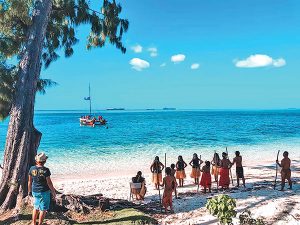Grand welcome for the Che’lu

Che’lu is cheered on by cultural dancers and onlookers as she arrives last Sunday at the Guma Sakman in the waters off Civic Center Beach in Susupe. (MAXINE LASZLO)
Boatloads of people witnessed the arrival of the traditional canoe called Che’lu at the Guma Sakman in the waters off Civic Center Beach in Susupe last Sunday.
The traditional Chamorro outrigger canoe, or sakman, was greeted on the beach around 2:05pm by the sounds of kulus, or Chamorro shell horns, and joyous singing. There were also dancers and a lot of food and music, according to 500 Sails executive director Pete Perez.
“Other 500 Sails canoes were in the water to sail in with us. We even had a small hammerhead shark [as] an escort in the lagoon,” he added.
On board the Che’lu were Perez himself, sakman captain Cecilio Raiukiulipiy, Mario Borja, who built the sakman with his crew in San Diego, April Repeki, Henry Maluweliu, and Ray Alvarez.
The grand welcome on Saipan was organized by the Chamolinian Cultural Village Inc./Canoe Federation and Reps. Ivan Blanco (R-Saipan), Sheila Babauta (Ind-Saipan), and Luis J. Castro (R-Saipan).
What makes Che’lu important is it’s a collaboration between the Sakman Chamorro organization of Saipan and the Che’lu organization of San Diego, Perez said.
“Saipan bought the redwood log and provided collected historical research on the Chamorro proas and San Diego built the canoe. The canoe was shipped to Guam where it has been since [the 2016 Festival of the Pacific Art], and was sailed there. But now it is on Saipan because we have swimming and sailing programs that are producing canoe sailors that can become crew for Che’lu as she begins a new life as a voyaging canoe,” he said.
Before arriving on Saipan, the Che’lu had overnight stops on Rota and Tinian where it had similar warm welcomes from the local community.
“Lots of people came out to welcome us and get a look at Che’lu when we arrived on Tinian and Saipan. On Tinian [Mayor Edwin P. Aldan] and the Indigenous Affairs Office organized a wonderful island greeting,” said Perez.
As recalled by Perez, Deborah Fleming described Che’lu’s arrival on Tinian this way: “Ai adai! It was dark when she came into the San Halum Harbor, just a green light glowing. …The island dancers greet[ed it] with songs and ukulele as [the] Che’lu is towed in, then [a] small boy call[ed] on the kulu as Che’lu is moored. She is a…sleek lady decked in ocher and black; her crew enlivened with scents of barbecue. All is well.”
Perez said it was beautiful to see and hear the Tinian people welcome them as the Che’lu arrived after two days of heavy seas and strong winds.
“Che’lu was towed after strong winds damaged both the lahi (yard) and the palauan (boom) during sea trials [in] Guam. Towing is very, very hard on a canoe and crew, but Che’lu proved very strong and we all were better mariners for the experience,” he said.
Along the way to Saipan, 500 Sails supplied two volunteer crews to man boats to escort the Che’lu to Saipan waters. The crew was manned by captain Juan Barcinas and Elvin Masga of Tinian, captains Alvin Iglesias and Cecilio Raiukiulipiy and Basilio Blas of Saipan, and Gus Hocog of Rota.
500 Sails is a cultural restoration project that aims to bring back the indigenous sailing traditions of the Marianas Islands, both Chamorro and Carolinian. Its goal is to have to have 500 sakmans or proas plying the Marianas waters by 2030.























